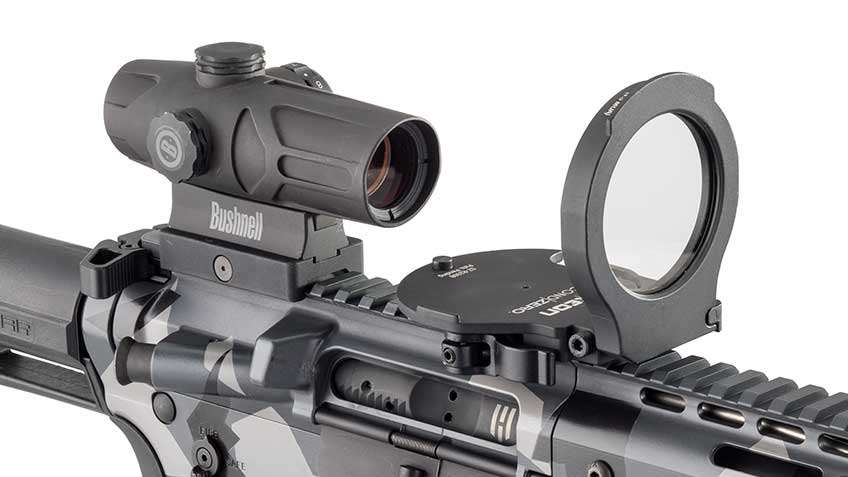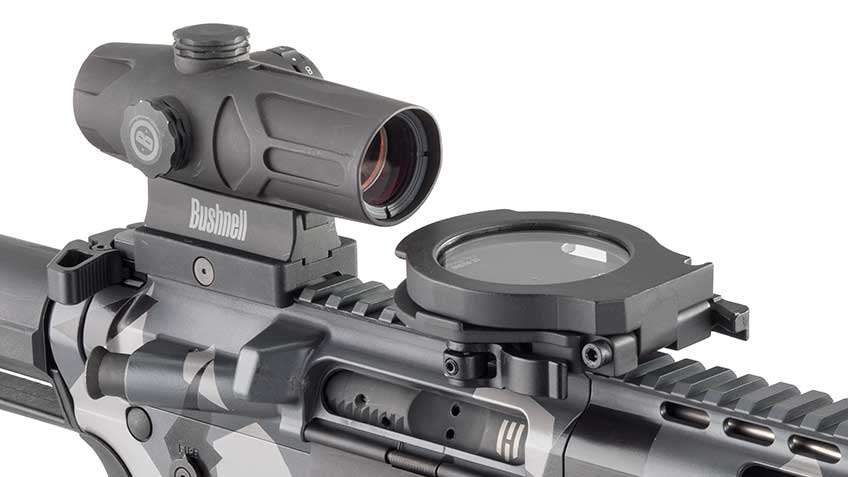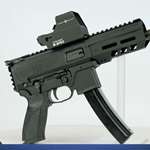
Compared with other bullet-drop-compensating (BDC) optics, the learning curve for the Axeon Optics Second Zero is fast and easy. It requires no math skills, no Bluetooth-connected cellphone app, and what you see when looking through it is the same as you’re accustomed to, because the Second Zero pairs with your existing optic and has no reticle or any other visible presence of its own. On top of that, it takes a couple minutes tops to mount one on your gun.
The Second Zero’s sole job is to provide an instant elevation up-adjustment of either 4.3 or 11.5 minutes of angle (MOA), depending on which of two variants you choose. Simply flip the single lens into alignment with your optic, and the adjustment is made, just as if you had dialed-in clicks.
The adjustments translate to elevating your scope’s 100-yd. sight-in to a 330-yd. zero (4.3-MOA model) or to a 530-yd. zero (11.5-MOA model). Understand, however, those are approximations based on an average of popular loads, and actual alternate zeroes will vary a bit, depending on ballistics and existing conditions.
Simplicity of use notwithstanding, the Second Zero is the result of considerable optical ingenuity. To you and me, what appears to be a simple lens, is actually, as Axeon describes it, “… precision-ground wedges (prisms) with dead-flat surfaces. Two wedges are assembled and frozen in place to achieve the minute-of-angle precision using a patented process.” Working in tandem, the prisms “shift the image to compensate for bullet drop.”
Watch the video provided by Axeon Optics Second Zero below:
They come encased in sturdy, folding aluminum-alloy or ballistic-polymer frames, packages that add just 4 to 7 ozs. to your shooting rig. There are two frame styles to fit users’ mounting preference. The Bell-Mount attaches directly to your scope’s objective bell in 40-44 mm or 50 mm sizes and will remind you of a protective scope cover. The Rail-Mount clamps to a Picatinny rail ahead of your optic in the same manner as other accessories.
As mentioned, you decide when and when not to deploy the Second Zero. The pivoting prism element locks tightly into place when you want it there, but otherwise, the glass sits out of the way and is barely noticeable. Given the shooting public’s perception of how robust optics’ construction and mounting must be, some shooters may wonder about a device that depends on repeated flip-up/down movements of the glass.
Though I knew that Umarex, the company handling Second Zero sales and distribution, would never come to market with a product that wasn’t fully vetted through range and field testing, I still had to see it at work when it was me pulling the trigger.
So I headed for our local 300-yd. range with two 4.3-MOA test units: 1) a Bell-Mount paired with a Remington Model 7 .308 Win. carbine, topped with a Leupold VX-5HD 3-15X, shooting SIG Sauer HT 150-gr. loads at 2,750 fps; and 2) a Rail-Mount atop a Head Down Firearms .224 Valkyrie equipped with a Bushnell AR Optics TRS-25 red-dot and firing Federal Premium 90-gr. Sierra MatchKings at 2,700 fps.

After confirming that both rifles were dead-on at 100-yds., I moved to the 300-yd. line to fire groups with and without Second Zero to compare shot trajectories, and to get a sense of the units’ consistency, I repeated that sequence three times.
Thanks largely to the 15X Leupold magnification on the Model 7 .308, groups with the SIG HTs remained a little over the 1 MOA group I got at 100-yds. With the non-magnified Bushnell red dot topping my Head Down AR, my groups widened to 2.5-MOA at 300. In both cases, however, the shift in point of impact from the Second Zero was pronounced and indeed proved to be consistent.
On average from the center-points of five-shot groups, the short-barreled Model 7 .308 hit 11.4” higher when using its Second Zero, and the bolt-rifle’s average group size went from 3.9” with just the Leupold scope, to 4.2” with the addition of the Second Zero.
Because of my inability to repeat a precise point-of-aim with the red-dot, even with the intensity turned down to the lowest setting, results from the Head Down Valkyrie were not as controlled as with the Remington. Three-hundred-yd. five-shot groups with it averaged 6.3”. That increased incrementally to 6.8” when the Second Zero was engaged. However, despite the enlarged groups, the elevation jump hovered right around 10.25” from one set of groups to the next.

For me it was interesting to note the difference between the two, but hardly a surprise that the flatter-shooting Valkyrie showed less point-of-impact shift than the .308 carbine, whose short barrel likely cost it in that regard.
Also noteworthy is that mean points of impact from both rifles were still a bit low at 300 yds; the Valkyrie was 4” below point of aim, while the .308 was 1.5” low. That’s why the Second Zero User Guide contains helpful caliber-specific effective-range tables. With the 4.3-MOA unit on a .308, the listed True Second Zero Range (from an initial 100-yd. sight-in) is 280 yds., which accounts for my bullet placement at 300.
As a general rule-of-thumb, Axeon’s website shows respective effective Second Zero ranges when shooting at a 9” target as: 280 to 360 yds. for the 4.3-MOA units; and 480 to 560 yds. with the 11.4-MOA. With high-velocity loads, targets within those windows should be hit without resorting to holdover. From a practical standpoint, it also shows the need to verify downrange results through actual firing on paper or steel targets.
For big-game hunting, any good shot from my .308 test rig would have a high hit-probability at 300 yds., no holdover or compensation required. However, my takeaway would be to dial up that rifle’s 100-yd. zero—and in fact, for non-magnums in the .270/.308/.30-06-class, I normally zero 1.5” high at 100 yds.

In this case, I’m confident that doing so would put me smack in the middle of a deer or elk’s vitals at 300 and would thereby extend my hold-dead-on range to 350+. The same principle applies to the .224 Valkyrie test rifle, but since the targets likely would be smaller, in particular when shooting varmints or furbearers, I’d opt for a 200-yd. initial zero. Then the Second Zero, I’m guessing, would center around 330 yds., but naturally I’d have to confirm that with shots on paper or freshly painted gongs.
For practical purposes, working from a 100-yd. zero is a round-number starting point Axeon provides for reference, and then the user fine-tunes from there. Help doing just that is available in user guide. A
Although the practical fit for using a Second Zero comes at what are now mostly considered mid-range targets, I sure can think of numerous potential applications, especially for hunting when you widen the field to include straight-wall cartridges, muzzleloaders and slug guns.
Interesting, too, would be using it on home-defense AR normally zeroed for 25 or 50 yds. The Second Zero could make that short-range defender a much more versatile 100- to 200-yd. tool, and by the way, the technology works with open sights, too.

Riflemen today have numerous choices in BDC optics. Their capabilities vary, and so will the best choice for given situations. However, none is faster than the Second Zero, whether learning to use it, or when you have a fleeting encounter afield.
Reliability is at least equal with any other BDCs I’ve used, and it virtually eliminates operator error, as well as battery loss and electronic interference. Affordability is another very strong selling point, as the Second Zero lists for $49.99 to $79.99, depending on model.
There are far more costly BDC devices available, including some that serve a similar function as the Second Zero. While they aim to facilitate long-range-precision in order to justify their elevated pricing, the cost also relegates them to the government-contract market for the most part.
In fact Axeon builds such optics, and the company will also purpose-build Second Zero units to customer specs. So if you can see yourself benefiting from a Second Zero or a related product, the Axeon Optics team would sure like to hear from you.





































